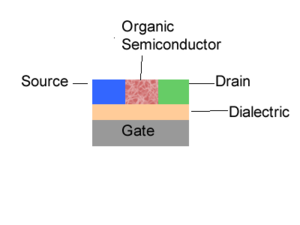Difference between revisions of "Organic Field Effect Transistors"
Cmditradmin (talk | contribs) (New page: ===Field effect transistors=== thumb|300px When you look at the field-effect transistors there are three major processes. The first one is the inject...) |
Cmditradmin (talk | contribs) m |
||
| Line 1: | Line 1: | ||
===Field effect transistors=== | ===Field effect transistors=== | ||
[[Image:Field_effect_transistor.png|thumb|300px]] | [[Image:Field_effect_transistor.png|thumb|300px]] | ||
A field effect transistor (FET) uses an electric field to change the conductivity of an semiconductor material. | |||
There are three major processes involved with field-effect transistors. The first one is the injection of charges into your semi-conductor. In the case of light-emitting diode and photovoltaic cell there are only two electrodes. However, in a field-effect transistor, the charge injection is modulated through a third electrode called a gate. Now all is needed are the electrons and the holes. Let’s suppose you inject electrons. Those electrons must migrate and be collected. The first electrode will be referred to as a gate. Then you have a thin insulator called a dielectric. You have two other electrodes referred to as the source and the drain. Then you have your organic semi-conductor. This is one of the configurations possible. When you are given a voltage difference between the source and drain, the amount of charges that will be injected into your semi-conductor will be modulated by the voltage at the gate. The gate will modulate the injection and produce a switching effect. For a given voltage between the source and drain, the voltage of the gate can either be decreased such that there is a small injection or current or it can be increased to have a very large injection of charges into your semi-conductor and a large current. These are the components that make a transistor, which is also called a three terminal devices because you have 3 electrodes. So once you have an injection of charges into the organic semi-conductor, those charges will travel and be collected at the other electrodes. These are the main steps in an organic semi-conductor; charge injection, charge transport, and charge collection. | |||
See Wikipedia on [http://en.wikipedia.org/wiki/Field_effect_transistor field Effect transistor] | |||
Revision as of 10:38, 8 September 2009
Field effect transistors
A field effect transistor (FET) uses an electric field to change the conductivity of an semiconductor material.
There are three major processes involved with field-effect transistors. The first one is the injection of charges into your semi-conductor. In the case of light-emitting diode and photovoltaic cell there are only two electrodes. However, in a field-effect transistor, the charge injection is modulated through a third electrode called a gate. Now all is needed are the electrons and the holes. Let’s suppose you inject electrons. Those electrons must migrate and be collected. The first electrode will be referred to as a gate. Then you have a thin insulator called a dielectric. You have two other electrodes referred to as the source and the drain. Then you have your organic semi-conductor. This is one of the configurations possible. When you are given a voltage difference between the source and drain, the amount of charges that will be injected into your semi-conductor will be modulated by the voltage at the gate. The gate will modulate the injection and produce a switching effect. For a given voltage between the source and drain, the voltage of the gate can either be decreased such that there is a small injection or current or it can be increased to have a very large injection of charges into your semi-conductor and a large current. These are the components that make a transistor, which is also called a three terminal devices because you have 3 electrodes. So once you have an injection of charges into the organic semi-conductor, those charges will travel and be collected at the other electrodes. These are the main steps in an organic semi-conductor; charge injection, charge transport, and charge collection.
See Wikipedia on field Effect transistor
